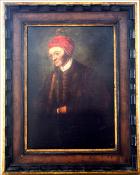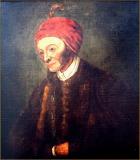Inscribed at the foot of the Portrait " Jedediah Buxton an extraordinary Calculator was born at Elmeton near Chesterfield 1704 and died 1774 aged 70. Theough the son of a schoolmaster and grandson of a clergyman he could neither read nor write. His mental powers were astonishing that in the midst of the most confused noise he would reply with accuracy to the most difficult questions. He was accidentaly asked by a stranger how many cubic eighths of an inch there were in a body whose three sides were 23,578 yards and though surrounded by a hundred labourers he in five hours gave a correct answer to the astonished stranger."
Buxton, Jedidiah (1707–1772), mental arithmetician, was born on 20 March 1707 at Elmton, Derbyshire, the eldest of four surviving children of William Buxton (1672–1739), originally from Chelmorton, but then a farmer and schoolmaster of Elmton, and his wife, Sarah (1677–1760), daughter of John Short of Elmton. His paternal grandmother, Ann, was married to John Davenport, vicar of Elmton. Buxton married Alice Eastwood (d. 1753) on 4 February 1733 at Kirton, Nottinghamshire; they had at least two children. Although his father was schoolmaster of Elmton, and his grandfather had been the vicar, he could not write; and his knowledge, except of numbers, was extremely limited. How he came to understand the relative proportions of numbers, and their progressive denominations, he did not remember. However this was his interest. He frequently took no notice of objects, and when he did, it was only with reference to their numbers. After hearing a sermon he knew nothing about its content other than that it contained a certain number of words which he had counted during its delivery.
Despite his father's profession Buxton never learned to write and throughout his life was employed as a farm labourer. His inability to acquire the rudiments of education seems to have been caused by his absorbing passion for mental calculations, which occupied his mind to the exclusion of all else, and in which he attained a degree of skill that made him the wonder of the neighbourhood. He was first brought into more general notice by a letter in the Gentleman's Magazine for February 1751, by George Saxe, a gardener employed by the duke of Kingston, which was shortly followed by further communications in August 1751 and November 1753 from a Mr Holliday, of Haughton Park, Nottinghamshire. Among the many examples of Buxton's arithmetical feats which are given in these letters may be mentioned his calculation of the product of a farthing doubled 139 times. The result, expressed in pounds, extends to thirty-nine figures, and can be verified by the use of a computer. Buxton afterwards multiplied this enormous number by itself. It appears that he had invented an original nomenclature for large numbers, a 'tribe' being the cube of a million, and a 'cramp' a thousand 'tribes of tribes'. In April 1754 he walked to London, where he was entertained by Edward Cave, editor of the Gentleman's Magazine, at St John's Gate. He was introduced to the Royal Society, before whom he gave some illustrations of his calculating powers. He was also taken to see Garrick in Richard III, but paid no attention to the performance except to count the words spoken by the actors. A memoir of Buxton, with an uncredited portrait in Gentleman's Magazine, June 1754, gives his age as forty-nine, which does not agree with the date of his birth in Elmton parish register at the time of his baptism.
He measured the lands of Elmton, consisting of some thousand acres (4 km2), simply by striding over it. He gave the area not only in acres, roods and perches, but even in square inches. After this, he reduced them into square hairs'-breadths, reckoning forty-eight to each side of the inch. His memory was so great, that in resolving a question he could leave off and resume the operation again at the same point after the lapse of several months. His perpetual application to figures prevented the acquisition of other knowledge. Among the examples of Buxton's arithmetical feats which are given are his calculation of the product of a farthing doubled 139 times. The result, expressed in pounds, extends to thirty-nine figures, and is correct so far as it can be readily verified by the use of logarithms. Buxton afterwards multiplied this enormous number by itself. It appears that he had invented an original nomenclature for large numbers, a 'tribe' being the cube of a million, and a 'cramp' (if Mr. Holliday's statement can be trusted) a thousand 'tribes of tribes'.
His mental acuity was tested in 1754 by the Royal Society when he walked to London, who acknowledged their satisfaction by presenting him with a handsome gratuity. During his visit to the metropolis he was taken to see the tragedy of Richard III. performed at Drury Lane theatre, but his whole mind was given to the counting of the words uttered by David Garrick. Similarly, he set himself to count the steps of the dancers; and he declared that the innumerable sounds produced by the musical instruments had perplexed him beyond measure.
A memoir appeared in the Gentleman's Magazine for June 1754, to which (probably through the medium of a Mr Holliday, of Haughton Hall, Nottinghamshire), Buxton had contributed several letters. In this memoir, his age is given as forty-nine, which points to his birth in 1705; the date adopted above is on the authority of Daniel and Samuel Lysons' Magna Britannia (Derbyshire).
His image can be seen online in the New York Library. A portrait by Miss Maria Hartley in 1764 hangs in Elmton Church.
Jedediah Buxton was the son of William Buxton, a farmer and also the schoolmaster at Elmton. However, the Vicar of Elmton was not Jedediah's biological grandfather. John Davenport, the Vicar of Elmton, 1689–1709, was the second husband of Ann (William Buxton's mother). She had been previously married to Jedidiah's paternal grandfather, Edward Buxton of Chelmorton.
A blue plaque was erected in Jedediah's honour in Elmton in 2011 after a public poll.
After spending some weeks in London, Buxton returned contentedly to his native village. His final years passed in relative obscurity. Local legend tells how he calculated the exact date that he would die, and that after farewells to his employer, family, and friends, he returned home, ate his supper, and died in his chair. He was buried on 5 March 1772 in an unmarked grave in St Peter's churchyard, Elmton.



